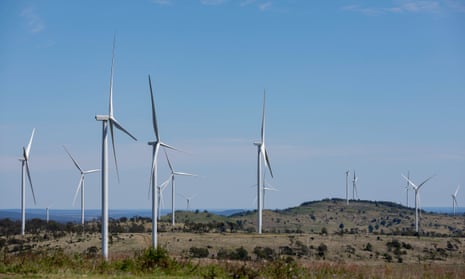Extract from The Guardian
Increased output from renewables, with a near-zero fuel cost, also nudged more coal and gas out of the generation market.t

Wed 25 Jan 2023 01.00 AEDT
Last modified on Wed 25 Jan 2023 01.02 AEDTWholesale power prices also retreated during the period, particularly after the Albanese government imposed price caps on black coal and gas that are used to generate power, AEMO said in its quarterly report released on Wednesday.
“Electricity futures prices saw steep falls in the mainland states through to the end of the quarter” after the price limits were imposed on 9 December, said Violette Mouchaileh, an AEMO executive.
The average price of $93/megawatt-hour across the national electricity market (NEM) that serves eastern Australia was less than half the $216/MWh cost in the September quarter. Still, it was almost 80% higher than for the final three months of 2021.
Renewable energy from wind, solar and hydro supplied an average of 40.3% of power in the NEM, a record for any quarter since the NEM started in 1998.
It exceeded the previous high, set a year earlier, of 35.8%, AEMO said.
The tail end of the third La Niña event in as many years trimmed power demand for daytime air-conditioning.
A 16% increase in electricity output from rooftop solar panels, or 410MW on average, also decreased demand from the grid.
As a result, operational demand fell 2% from a year earlier to an average 19,431MW, the lowest December quarter reading. New record lows for a quarter were set in South Australia, Victoria and New South Wales, while the 11,892MW use on 6 November was a new low for the NEM in the December quarter.
The government hailed the early signs of a retreat in wholesale power prices as early proof that its price caps were having an effect on household bills. However, wholesale prices make up only about a third of retail costs and are subject to external events, such as an extended fault at coal-fired power plant, or heatwave-driven spikes in demand that could erase price falls.
Wholesale costs may also have been lower due to a drop in gas prices from record highs in June and July. At an average of $17.79/gigajoule, though, the price remained two-thirds higher than a year earlier.
Gas demand actually fell 7% in the December quarter from a year ago in part because of lower LNG production after unplanned outages at export plants in Queensland.
Power generation from black and brown coal-fired plants was the lowest since the NEM started. Higher prices for the fossil fuel in Queensland and NSW – at least before the price caps began – was one factor for the reduced use but also plant failures, particularly in Queensland.
Increased output from renewable energy, with its near-zero fuel cost, also nudged more coal and gas out of the generation market.
New instantaneous renewable penetration records were set in the NEM at 68.7% on 28 October – up 4.6 percentage points on the previous record – and in the Western Australian market at 84.3% on 12 December, up 3.7 percentage points. The records were “largely driven” by rooftop solar, AEMO said.
During a fault that cut South Australia off from other states for several days in November, renewables’ share of generation peaked at 91.5%.
“Output from wind and grid-scale solar grew strongly as new facilities were connected and commissioned,” AEMO said. Even with relatively calm days producing the lowest recent quarterly utilisation rate, total windfarm output exceeded any previous December quarter.

No comments:
Post a Comment